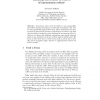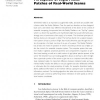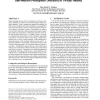72 search results - page 10 / 15 » Neck range of motion and use of computer head controls |
HAPTICS
2006
IEEE
14 years 1 months ago
2006
IEEE
We examine the motion control bandwidth and stable impedance range of the Cobotic Hand Controller, a novel, six-degree-offreedom, admittance controlled haptic display. A highly ge...
DRUMS
1998
Springer
13 years 11 months ago
1998
Springer
Autonomous robots need the ability to move purposefully and without human intervention in real-world environments that have not been speci cally engineered for them. These environm...
CGF
2005
13 years 7 months ago
2005
Interactive control of a physically simulated character is a challenging problem, due both to the complexity of controlling multiple degrees of freedom with lower dimensional inpu...
PRESENCE
2002
13 years 7 months ago
2002
Diminished reality is as important as augmented reality, and both are possible with a device called the Reality Mediator. Over the past two decades, we have designed, built, worn,...
VRST
2006
ACM
14 years 1 months ago
2006
ACM
Despite amazing advances in the visual quality of virtual environments, affordable-yet-effective self-motion simulation still poses a major challenge. Using a standard psychophysi...



